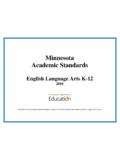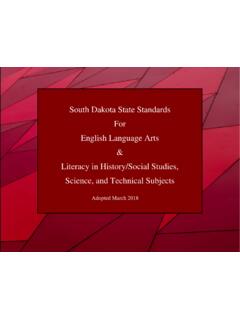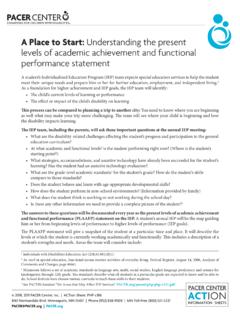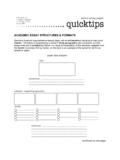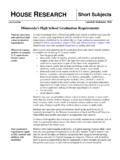Transcription of Student Conduct Code - regents.umn.edu
1 Board of Regents Policy: Student Conduct Code Category: academic Last Amended: October 13, 2017 Page 1 of 8 BOARD OF REGENTS POLICY: Student Conduct Code SECTION I. SCOPE. This policy applies to all students and Student groups at the University of minnesota (University), whether or not the University is in session. SECTION II. GUIDING PRINCIPLES. (a) The University seeks an environment that promotes academic achievement and integrity, that is protective of free inquiry, and that serves the educational mission of the University. (b) The University seeks a community that is free from violence, threats, and intimidation; that is respectful of the rights, opportunities, and welfare of students, faculty, staff, and guests of the University; and that does not threaten the physical or mental health or safety of members of the University community.
2 (c) The University is dedicated to responsible stewardship of its resources and to protecting its property and resources from theft, damage, destruction, or misuse. (d) The University supports and is guided by state and federal law while also setting its own standards of Conduct for its academic community. (e) The University is dedicated to the rational and orderly resolution of conflict. (f) Students are entitled to the rights and responsibilities of other citizens with regard to freedom of speech, peaceable assembly, and right to petition. Students are entitled to exercise their rights to inquire and dissent, speak freely, and peaceably assemble and protest to the extent permissible under both the First Amendment and the Student Conduct Code. (g) Students are entitled to due process and procedural fairness protections, including the prompt notification of charges, the opportunity to respond, the right to an advocate of choice, and the right to the resolution of a case within a reasonable period of time.
3 SECTION III. DEFINITIONS. Subd. 1. academic Environment. academic environment shall mean any setting where a Student is engaged in work toward academic credit, satisfaction of program-based requirements, or related activities including but not limited to on line courses, learning abroad, and field trips. Board of Regents Policy: Student Conduct Code Category: academic Last Amended: October 13, 2017 Page 2 of 8 Subd. 2. Campus. Campus shall mean all University premises, including all land, buildings, facilities, and other property owned, possessed, leased, used, or controlled by the University, and adjacent streets and sidewalks. Subd. 3. Plagiarism. Plagiarism shall mean representing the words, creative work, or ideas of another person as one s own without providing proper documentation of source.
4 Examples include, but are not limited to: copying information word for word from a source without using quotation marks and giving proper acknowledgement by way of footnote, endnote, or in-text citation; representing the words, ideas, or data of another person as one s own without providing proper attribution to the author through quotation, reference, in-text citation, or footnote; producing, without proper attribution, any form of work originated by another person such as a musical phrase, a proof, a speech, an image, experimental data, laboratory report, graphic design, or computer code; paraphrasing, without sufficient acknowledgment, ideas taken from another person that the reader might reasonably mistake as the author s; and borrowing various words, ideas, phrases, or data from original sources and blending them with one s own without acknowledging the sources.
5 It is the responsibility of all students to understand the standards and methods of proper attribution and to clarify with each instructor the standards, expectations, and reference techniques appropriate to the subject area and class requirements, including group work and internet use. Students are encouraged to seek out information about these methods from instructors and other resources and to apply this information in all submissions of academic Subd. 4. Student . Student shall mean any person taking courses at the University or enrolled in a University program; any person participating as a Student in University activities prior to the start of classes; any Student who is not enrolled or registered for a particular term but has a continuing relationship with the University; any Student who withdraws, transfers, or graduates after an alleged violation of the Student Conduct Code; and any already graduated Student when the Conduct at issue implicates the Student s University degree.
6 Subd. 5. Student Group. Student group shall mean any group of students that is or has been registered as a University Student group under applicable University policies or procedures. Subd. 6. University-Sponsored Activities. University-sponsored activities shall mean any program or event sponsored by the University, including but not limited to those sponsored by Student groups, or athletics. Subd. 7. Medical Amnesty. Medical amnesty shall align with minnesota Statutes , Subd. 8, and it shall mean that a Student is not subject to Student Conduct Code disciplinary sanctions for underage possession and consumption of alcohol if the Student contacts a 911 operator to report that the Student or another Student is in need of medical assistance for an immediate health or safety concern.
7 To be eligible for medical amnesty, the Student who initiates contact must be the first person to make such a report, must provide a name and contact information, must remain on the scene until assistance arrives, and must cooperate with the 1 Portions used with permission from New York Institute of Technology and University of Texas, San Antonio. Board of Regents Policy: Student Conduct Code Category: academic Last Amended: October 13, 2017 Page 3 of 8 authorities at the scene. The Student who receives medical assistance and up to two students acting in concert with the Student initiating contact with a 911 operator shall also be immune from disciplinary sanctions. Subd. 8. Assists or Abets. A Student or Student group assists or abets prohibited Conduct when the Student or Student group: (a) helps any other person engage in misconduct as defined by the Student Conduct Code; and (b) intends the misconduct to occur or knows that their actions are significantly likely to help the other person to engage in the misconduct.
8 SECTION IV. DISCIPLINARY OFFENSES. Any Student or Student group found to have committed, attempted to commit, or assisted or abetted another person or group to commit the following misconduct is subject to appropriate disciplinary action under this policy: Subd. 1. Scholastic Dishonesty. Scholastic dishonesty means plagiarism; cheating on assignments or examinations; engaging in unauthorized collaboration on academic work; taking, acquiring, or using course materials without faculty permission; submitting false or incomplete records of academic achievement; acting alone or in cooperation with another to falsify records or to obtain dishonestly grades, honors, awards, or professional endorsement; altering, forging, misrepresenting, or misusing a University academic record; or fabricating or falsifying data, research procedures, or data analysis.
9 Subd. 2. Disruption of academic Environment. Disruption of the academic environment means engaging in behavior that substantially or repeatedly interrupts either the instructor s ability to teach and/or a Student s ability to learn. Subd. 3. Falsification. Falsification means willfully providing University offices or officials with false, misleading, or incomplete information; forging or altering without proper authorization official University records or documents or conspiring with or inducing others to forge or alter without proper authorization University records or documents; misusing, altering, forging, falsifying, or transferring to another person University-issued identification; or intentionally making a false report of a bomb, fire, natural disaster, or other emergency to a University official or an emergency service agency.
10 Subd. 4. Refusal to Identify and Comply. Refusal to identify and comply means willfully refusing to or falsely identifying one s self or willfully failing to comply with a proper order or summons when requested by law enforcement personnel, by emergency medical staff responding to an emergency, or by a University employee acting within the purview of his or her job responsibilities. Subd. 5. Attempt to Injure or Defraud. Attempt to injure or defraud means making, forging, printing, reproducing, copying, or altering any record, document, writing, or identification used or maintained by the University when done with intent to injure, defraud, or misinform. Subd. 6. Harm to Person. Harm to person means engaging in Conduct that endangers or threatens to endanger the physical and/or mental health, safety, or welfare of another person, including, but not limited to, threatening, harassing, intimidating, or assaulting behavior.

